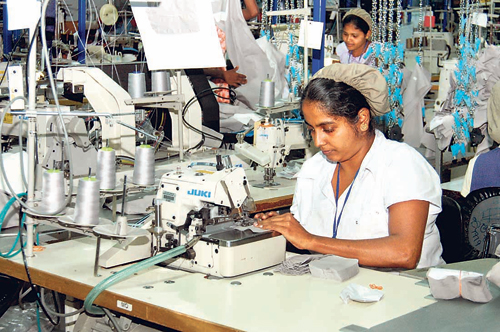Energy and water consumption high in apparel sector

A worker in a garments' factory.
As far as Sri Lanka’s apparel sector is concerned there is a huge increase in consumption patterns where energy, water and global emissions are over 50 percent and there is waste creation, said Dr. Ananda Mallawatantri, Country Representative IUCN at a webinar held in Colombo last week on the topic “Road Map to a Greener Apparel Sector”.
He said that a lot of thinking is going on to reduce the carbon footprint following the Paris agreement and many other conventions. Having realised the situation importers of well- known brands of local apparel and manufacturers adopted new strategies to overcome this barrier.
But what is lacking is a concerted approach by all apparel sectors to adopt a common strategy and work together to achieve sustainable development. Many local companies today are eager to know which companies pollute the environment for that matter. Engaging renewable energy such as solar power is conducive to the environment and shifting away from fossil fuels to manufacture apparels will benefit Sri Lanka. The government is also looking at zero discharge of hazardous chemicals to the environment where the private sector can play an important role. Sustainable finance is also linked to environment, social and government structures will encourage business to Sri Lanka. Banks should also be involved in the process to augment the supply chain mechanism. Meanwhile importers of apparels in future may query on energy used for manufacture and impose a tax levy depending on higher energy limits, he said.
Sanjaya Mohottala, Chairman – Board of Investment (BOI), said that environment friendly businesses is a pre-requisite for future exports. It is paramount that they provide infra-structure facilities and support for Sri Lankan companies. In the BOI zones, Sri Lankan companies produce high quality garments whereas countries such as Bangladesh produce low valued garments on a day to day basis.
“We have taken steps to upgrade water treatment plants at Koggala, and Biyagama and Katunayake free trade zones. Waste water disposal from plants are done adhering to highest standards. Sri Lanka exports over US$ 5 million annually,” he added.
Saliya Wickramasuriya, Co-Chair National agenda committee on energy of the Ceylon Chamber of Commerce, said all ships no matter what they do are obliged to emit less zinc sulfur into the atmosphere than they did before with effect from January 2020 to protect the ocean.
The Ceylon Chamber is collaborating with the government to draft a document on de-carboning to protect the environment. Meanwhile a cabinet paper is expected to be submitted shortly in this regard.
Tuli Cooray, Secretary General, Joint Apparel Association Forum of Sri Lanka (JAAF), said the industry was engaged in the practices for ethical manufacturing and showcasing for a sustainable and sourcing destination.
The IUCN research supported by HSBC has created a roadmap for a greener apparel sector and the SME sector companies in particular will be the beneficiaries of this proposal.
The HSBC-IUCN report is a result of a first of its kind study conducted over one and a half years that contains key finding and recommendations for a low carbon transition. JAAF, the Bankers Association, the BOI and the National Greener Protection Center supported the project as a strategic partnership.


